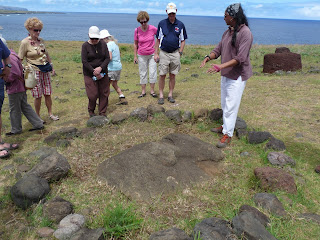Lunch was followed by a walking tour of old Santiago, a visit to an old cathedral and a short talk on the troubles with Salvador Allende and Pinochet. Alex’s father died as a result of those events. After a metro ride back to the hotel, we got another break and went to dinner at El Giratorio, a revolving restaurant with wonderful views of the city – and got more fish! This time, real Chilean sea bass.
 January 7 – up early to leave for the airport by 7:30 am for the 5 hr flight to Easter Island. Our room on the island is pretty basic, but comfortable. TV is all Spanish and comes in on rabbit ears, so visibility is less than sterling. We walked to Hanga Roa for lunch (most everyone had empanadas – shrimp for Jim, but I opted for ‘carne’ –so-so hamburger and no salsa to spice it up) and looked at a couple of moai that had been restored in town.
January 7 – up early to leave for the airport by 7:30 am for the 5 hr flight to Easter Island. Our room on the island is pretty basic, but comfortable. TV is all Spanish and comes in on rabbit ears, so visibility is less than sterling. We walked to Hanga Roa for lunch (most everyone had empanadas – shrimp for Jim, but I opted for ‘carne’ –so-so hamburger and no salsa to spice it up) and looked at a couple of moai that had been restored in town. There is a lot more to the story of the ‘Easter Island Heads’ than you think. The iconic photos of heads standing in grass on a hillside is not a true reflection of what they were there for. The famous photos are of maoi that were still under construction and abandoned when the moai cult suddenly lost its influence. Even the heads that you see are actually bodies down to (but not including) the legs, they are just buried in dirt either to facilitate working on the tops or because they got dirt blown around them in the hundreds of years after they fell from favor. They represent important people and were placed on an ahu (a platform atop a burial chamber), typically facing inland. They also got eyes of white coral and obsidian, and the eye sockets were apparently hollowed out on the ahu site. Often, there is only one on a platform, but some larger graves have more.
All of the completed moai were toppled between 1770 to 1825 for unclear reasons. One theory says it was tribal warfare when the island was overpopulated and tribes destroyed the ‘protectors’ of competing tribes. Another theory says that the wood was exhausted, the ecosystem was collapsing, people were starving and attacked their ‘gods’ for not taking care of them. The island was heavily depopulated by rampant Peruvian slavers in the mid 1860s and disease brought by returning slaves and by missionaries nearly finished them off, reducing the native population to 111 at one point. Now there are are about 3,000 Rapa Nui (natives' name for themselves and their island) on the island, along with about 2,000 to 3,000 other people, mostly Chileans.
About 54 moai have been restored to their former positions, and some of them should also have topknots – reddish lava representing a topknot hairdo like in old Japan – indicating a higher level of importance.
Our bus picked us up in town and we headed out to an ahu with toppled moai at Vaihu. Our local guide, a Rapa Nui named Matua, showed us a head face up lying flat in the sand and pointed out the carvings from the eyes and noted that the moai we would see the next day at the quarry did not have the hollowed-out eye sockets. This ahu is especially interesting because the stone foundation is of a design similar to the Inca construction in Peru that we saw about 7 years ago. There is a theory that the Rapa Nui are primarily Polynesian, but also included immigration from Peru, but this does not seem to be borne out by DNA testing.
 |
| Matua explaining about eye sockets. |
 |
| Lynn in front of stone 'bricks' similar to Incan ones. |
 |
| Four moai that have been pushed forward onto their faces. Note that their backs were to the ocean. There is a fallen topknot in the right foreground. |
 |
| Motus - the largest is where the sooty tern nests. |
 |
| "Vacation homes" -- entrances are VERY short. |
 |
| Rano Kau Crater |
Next, we headed to AnaKai Tangata, a shallow cave with paintings from the birdman times. I found the rock formations interesting too. Then it was back to the hotel for the night.
 |
| Sunset in Hanga Roa |